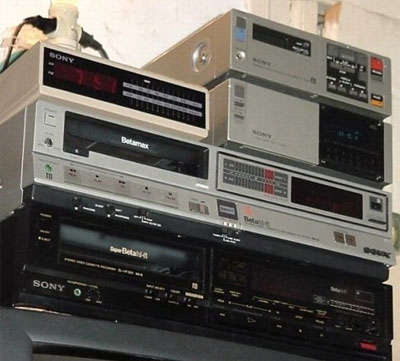I have this love/hate relationship with format wars.
No, it's not reality television versus talk shows, or Top 40 radio against "the best of the '80s—and more!" The wars I'm thinking about pit technologies against one another, usually in a battle to the death of one or more of the contestants. It's One format to rule them all every time, and the streets are littered with the remains of the losers.
These wars are loathsome because we consumers have to pick a side or else lose out on something awesome, and then the ones who picked the wrong one have to pay up again for the winning technology. But format wars also keep the carousel of progress spinning and fan the flames of innovation. Join me for a brief look back at the format wars of yesteryear, and a look ahead at what will replace them.
Betamax v. VHS
Let's start with some well-known and fairly recent history. Sony launched the home video revolution in 1975 with the Betamax tape format; the company asked Japan's Ministry of Trade and Industry to make Beta an official standard with government backing, but JVC refused to play ball and introduced its own VHS system a couple of years later. The rest, as they say, is history. But why did VHS tapes kill Betamax?
It wasn't because VHS was technically superior—Betamax tapes started out with slightly higher resolution than VHS, and less video noise as well. Also, Sony's more sophisticated lacing system (the way the tape winds between guides and read/write heads in the player) allowed Betamax to pull off a few tricks that early VHS players couldn't duplicate. You could fast-forward or rewind Beta tapes without losing the picture, for instance, and video editing on a Beta system produces cleaner cuts.
JVC's format roared onto the market with a couple of distinct advantages, though. Chief among them was the ability to record two hours of NTSC-encoded video versus one hour for Betamax.

Image credit: Wikimedia Commons
American consumers seemed to be more interested in long recordings than good-looking ones, and VHS quickly gained the upper hand in the US market. Sony fought back with thinner Beta tapes and slower tape speeds, extending the play time at the expense of picture quality, but JVC and a host of allies had already turned their short-lived tape length advantage into economies of scale. The rich get richer, and mass-produced video players get cheaper; soon enough, the technical superiority of Betamax mattered not a whit and VHS scored an 85% global market share by 1986.
In 1988, Sony started to make VHS players and Beta was left to die on the vine. The Video 2000 system from Philips, which also was arguably better than VHS but also more costly, never gained traction and sunk without a trace. At best, V2000 was about even with the already-dying Betamax at 7.5% market share each. The war was over by then.
So why was this war ever started? If JVC hadn't decided to go its own way, Betamax would have won by default. Short of a customer revolt, video tapes would then have been stuck with one hour of high-quality video signal for years. The series of compromises from both the Betamax and VHS camps that finally produced 10-hour recording times with very, very lossy quality might or might not have happened, and at any rate would have come about at a much slower rate.
Early adopters of both VHS and Betamax shelled out $1,000 or more (in 1980 dollars—over $2,400 when adjusted for 30 years of inflation) for their fancy new technology, and some of them ended up with expensive paperweights. But the rest of us ended up with better and cheaper players, packed with features designed to outdo the opposition. All told, the VHS-Betamax war was more good than bad for the average video watcher.
DVD, HD DVD, and Blu-ray
When DVD players started showing up in American living rooms, the VHS incumbents crawled out with nary a fight. DVD versus VHS was less of a war than a wholesale slaughter, and the age of magnetic video tapes ended with little fanfare in 2006 when the last major studio powered down the tape machines. That was allegedly the William Hurt vehicle "A History of Violence," filmed in 2005 but released on DVD and VHS in March, 2006. Thanks for the memories, Bill.
But there was another war going on at the VHS format's funeral. Sony was back in the trenches to promote the Blu-ray format. On the other side of the new battlefield stood HD DVD, championed by Toshiba and NEC. The first HD DVD player and a handful of movies were launched in April 2006, a month ahead of the first Blu-ray hardware.

Early reviews for either format were not overly positive. My colleague Nate Anderson summed the situation up thusly: "The consensus seems to be: unless you need it now, you're better off waiting a year. Prices will be down, quality will be up, and features will be multiplied. You'll also have a lot more content to watch on your shiny new device."
Nate was absolutely right, of course. Sony launched the PlayStation 3 in time for the holidays, and that console is still the leading Blu-ray player on the market with over 24 million systems sold. Early high-def disc players could only display 1080i video, but full-on 1080p hardware was not far behind. Toshiba presented a triple-layer HD DVD format that evened up the data storage capacity between the two combatants.
And of course, prices fell through the floor. You can get a refurbished Blu-ray player today for about $110, which is better than 90% off from the debut hardware.
While the Betamax-VHS bout lasted for more than a decade, the fat lady sang for HD DVD only 18 months after the inital hardware launch.
reader comments
99